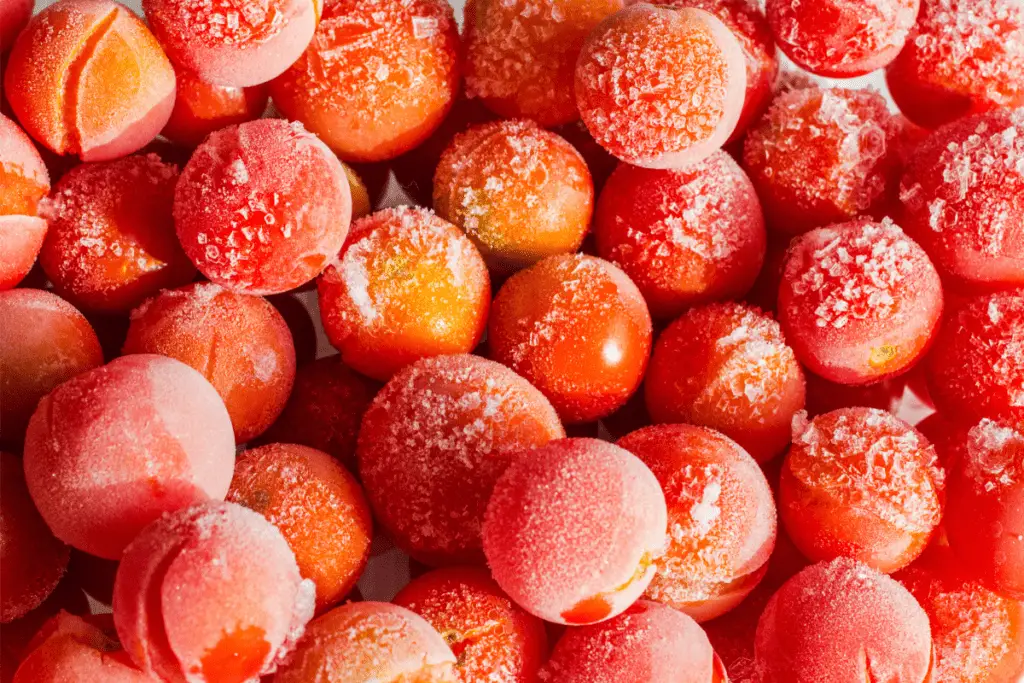
Tomatoes can be frozen with or without blanching, depending on preference. The essential equipment needed for freezing garden tomatoes includes a freezer bag, container, and freezing space. Fresh garden tomatoes are determined by firmness and the intensity of the red color. Avoid picking tomatoes that have blemishes or dark spots on them. Ensure to pick tomatoes that have weight since these have more matter. The tomato should feel firm and soft but not too soft to give real pressure. Pick tomatoes that produce an aromatic smell when you inhale near the stems to which your tomato was attached too. These steps ensure you pick the top cream of fresh garden tomatoes, thus getting perfect results after the freezing period is over.
Best Methods to Freeze Garden Tomatoes
There are three viable choices to pick from when deciding how to freeze your fresh tomatoes. Do you freeze them whole, chopped, sliced, or pureed? Sliced chopped and pureed forms are the best options when dealing with limited freezing space since this way, you can fit many tomatoes. Whole tomatoes are cored but not cut. Pureed tomatoes are cored, sliced, and made to a puree using a food processor to form a liquid. Chopped tomatoes are cored, sliced, and then chopped before packaging. Sliced tomatoes are simply cored, sliced then frozen.
The second batch of options to pick from when freezing them is the peeled(blanched) or unpeeled state. Peeling (blanching) tomatoes takes about 30 to 60 seconds in hot boiling water. Its advantage upon freezing is the consistent texture it provides when thawing them. Unpeeled tomatoes have extra nutrients and fibers if you view the freezing process from a healthy point of view. However, the skins can be stringy and chewy after the freezing process. The third selection of options to pick from when freezing fresh tomatoes is the raw and cooked state.
Freezing raw tomatoes saves one the cooking process and time. However, the thawing process after freezing results in mushy textured tomatoes. Please refrain from using these tomatoes in recipes that call for fresh tomatoes. Cooked tomatoes have the advantage of lasting longer in the freezer than their raw partners. Pick the best way to freeze your garden tomatoes while considering the information provided above.
Steps to Freezing Tomatoes Without Blanching
1. Gently rub your tomatoes under cool running water to clean off dirt. Cut off the tomato stems.
2. Dry the tomatoes thoroughly, one at a time, using a clean or paper towel. Add an extra dub where the branch was to dry off any water on it.
3. After the washing process, cut off the stem scar and surrounding blemishes and discard them.
4. Place the tomatoes on a baking sheet or pan in a single layer where no tomato touches the other. It is optional since some people argue that placing them whole or cut up on baking sheets for freezing exposes the tomatoes to excess air, which results in freezer burns and an unpleasant taste. However, if you opt to use the sheets, place them in the freezer for only one hour and remove them for packaging.
5. Package the tomatoes in jars or containers as preferred. When using plastic freezer containers, leave at least one inch of headspace to provide space for excess air to be expelled before sealing.
6. Label containers according to date and time of placement on the fridge. Tomatoes should ideally be frozen for about 6 months, so dating is paramount.
7. When partially freezing tomatoes, go for baking sheets that fit into your freezer. Partial freezing before packaging stops the tomatoes from sticking together. This way, you can remove the exact amount you require.
There are advantages and disadvantages to freezing garden tomatoes which makes it ideal for storage. Frozen tomatoes often make the best sauces, stews, soups, and curries. Here are reasons and reasons not to freeze your garden tomatoes.
Advantages
- It is a straightforward and convenient method of preserving large quantities of tomatoes from your garden.
- It is a fast process since one does not have to pre-cook. Wash your tomatoes, cut off the stems, place them onto a freezer bag and freeze.
- They are excellent for recipes where tomatoes need to be cooked, such as casseroles.
- One can package fresh garden tomatoes in small quantities, which allows them to further ripen and not heat up the kitchen. This is the opposite of canning, where one requires large amounts of tomatoes to fill a jar. Opt for freezing, especially if you grow indeterminate tomatoes as they ripen throughout the season instead of determinates.
Disadvantages
- Frozen tomatoes lose texture upon thawing since they get mushy. The freezing process breaks down pulp fibers that contain water, which results in the tomato expanding as they freeze.
- Frozen tomatoes are definitely not as flavorful as fresh tomatoes. The cold renders enzymes responsible for a tomato taste inactive on temperatures below 50 degrees Fahrenheit.
- Children and picky eaters may dislike thawed tomatoes, especially if the texture is totally unappealing. Solve this by using them solely for cooking as they do great that way.
- Freezing tomatoes take up much freezer space compared to other preservation forms such as canning. Want to learn to can your tomatoes? Check out our How Do You Can Tomatoes article.
- You can offset the disadvantage of mushy watery tomatoes by freezing several tomatoes together since some have more juice than others. Alternatively, slice the garden tomatoes in halves and remove the seedy and liquid part before freezing. You can also freeze them in their juicy state and during the thawing process, reserve the watery element to use for stock soups. It avoids wastage of healthy tomato content.
Containers and Bags Suitable for Freezing Garden Tomatoes
When deciding what containers are best for freezing tomatoes, go for options with proper water retention abilities. Chopped tomatoes in a freezer are as good as any liquid since they are incredibly juicy. Pick containers or bags that come with solid seals to prevent freezer burns and an acid taste to the tomatoes. It is advisable to go for easily stackable containers since they save valuable freezer space. Lastly, pick containers and bags that can retain adhesive labels. This is essential in saving money for purchasing containers all the time since this way, you can recycle them by changing the labels. Below is a collection of the best types of containers for freezing tomatoes:
1. Plastic freezer containers
They are made from rigid plastic and are often cube-shaped to allow proper stacking in the freezer. The stiff state makes them ideal for the storage of chopped tomatoes especially. Most plastic freezer containers are dishwasher safe and have considerable longevity. When picking plastic freezer bags, go for those labeled ‘freezer quality.’ Plastic containers come in various shapes and sizes, ranging from a pint to a quart. Confirm that the lids seal tightly.
Advantages
- Longevity where they are reusable year to year.
- Comes in consistent sizes suitable for neat stacking in a freezer
- Readily available in most discount department stores during the growing season. They are easy to find all year round in most online stores.
Disadvantages
- The initial cost of freezer containers is higher as compared to freezer bags. However, they are a one-time purchase as they do not require replacement every other year.
- Freezer containers require storage space when the tomato season is over, cumbersome.
2. Freezer bags
Freezer bags are readily available at grocery and discount stores. There are several brands to choose from, such as Ziploc, Hefty, Grand, and many more. Freezer bags are considerably more potent than ordinary plastic storage bags, and they are effective at preventing freezer burns. The majority come with plastic zippered closures for sealing. This way, tomatoes can be drained into the freezer bags, have excess air removed, preferably with a straw or knife, and have it zipped. Layering the freezer bags side to side saves space and allows extra stacking. They come in pint, quart, and gallon sizes.
Advantages
- Quite inexpensive
- Available throughout the year on grocery and online stores.
- Versatile since they are washable and can be recycled.
Disadvantages
- They have a short life span of about one to two seasons.
- Awkward stacking may result since the bags adopt the shape of their contents. To avoid this, carefully pack your tomatoes and freeze the bags flat later.
3. Vacuum-sealed bags
Vacuum sealers are ideal for bulk tomato storage as they allow preservation for up to 2 to 3 years, where initially, they would have lasted 6 to 12 months using other methods. The vacuum sealer sucks out air from the plastic bag, thus creating an air-tight seal with a heat strip. They are used with sealing bags and come in rolls.
Advantages
- Excess air is expelled, keeping tomatoes fresh for longevity.
Disadvantages
- Vacuum sealed bags are expensive to use since bags cannot be recycled. Vacuum sealers, heat trips and unique bags must be repurchased.
- The time and effort required to use them are tiring. Chopped tomatoes, for instance, must be initially frozen before pouring into the bags. Failure to do that causes the liquid to seep through the bag’s ends during vacuuming and sealing. To avoid seepage, freeze the chopped tomatoes flat before packing them in the vacuum bags. Freezing whole tomatoes using the method is more manageable than chopped ones.
- Storage of the vacuum sealing apparatus is cumbersome for small spaces since it must be kept away when off use.
Freezing garden tomatoes requires preparation and research on what methods and styles best suit your needs. Ensure to set your freezer at 0 degrees F or below for a proper freezing process. Frozen tomatoes will be flavorful for up to 12 months. Apply tips given above to enjoy frozen tomato recipes for up to 6 months.
This post contains affiliate links. If you make a purchase through these links, we may receive compensation at no additional cost to you.
